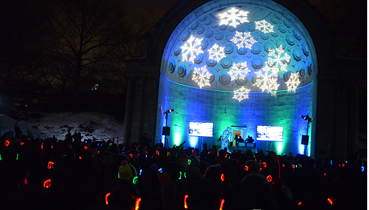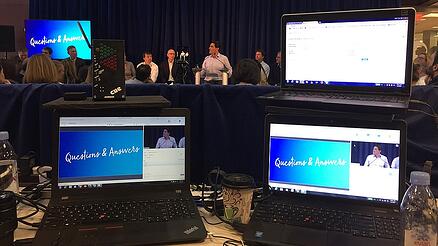 In recent years, new and developing technologies have changed how we think about events. From the experiential wonders of virtual reality, to the delightful absurdity of a silent DJ, the limitations of what we can see and hear at a live event are being continuously pushed. For the corporate world, these new technologies have opened the door to new platforms of efficiency and collaboration, creating a new kind of event entirely: The Hybrid Meeting.
In recent years, new and developing technologies have changed how we think about events. From the experiential wonders of virtual reality, to the delightful absurdity of a silent DJ, the limitations of what we can see and hear at a live event are being continuously pushed. For the corporate world, these new technologies have opened the door to new platforms of efficiency and collaboration, creating a new kind of event entirely: The Hybrid Meeting.
PLATFORMS
Familiar to most as “webcasting” or “videoconferencing”, these Hybrid Meetings are blossoming in the events world, and in many different flavors. Already, the means to share or broadcast our own personal events exist in the form of Facetime, Facebook Live…etc. For businesses, a smart phone isn’t quite enough to capture the full experience; however, the principles can be similar. Combining visuals with sound can manifest in any number of ways. Some platforms offer highly customizable user experiences complete with company branding to display virtually any type of media that they might wish to present; others are more of a one-size-fits-all approach. Even still, some businesses are pioneering new platforms entirely which cater only to their specific audiences, and all in a totally private and secure way.
INTERACTIVE
 What does that all mean for users? Lights, camera, nor a moment of action are left out for participants in every corner of the globe who are now experiencing meetings and events as close to live-and-in-person as is possible from the comfort of their own home or workspaces. No details are spared either; the very same visual content that is meticulously prepared and rehearsed is broadcasted and received instantaneously. The graphs showing financial performances through Q1 right alongside the reassuring smile of a CEO has allowed businesses to reduce their travel costs, without sacrificing the impact on employees or stakeholders that they rely on these events to have. Presenters are even able to engage in real-time with their remote audience via Q&A features. Questions are sent in from the user-end of these platforms to a curator at the other side, and can be addressed right then and there.
What does that all mean for users? Lights, camera, nor a moment of action are left out for participants in every corner of the globe who are now experiencing meetings and events as close to live-and-in-person as is possible from the comfort of their own home or workspaces. No details are spared either; the very same visual content that is meticulously prepared and rehearsed is broadcasted and received instantaneously. The graphs showing financial performances through Q1 right alongside the reassuring smile of a CEO has allowed businesses to reduce their travel costs, without sacrificing the impact on employees or stakeholders that they rely on these events to have. Presenters are even able to engage in real-time with their remote audience via Q&A features. Questions are sent in from the user-end of these platforms to a curator at the other side, and can be addressed right then and there.
THE NUMBERS
With such upside to these tools, there’s no wonder it’s catching on. For our team, over the last two years alone, the number of events that catered to remote audiences has grown by over 94%, resulting in weekly nation-wide broadcasts. In the modern data-driven world, many of these hybrid meetings are even serving as a barometer of attendee engagement, producing quality analytical information on their remote audiences. How many people tuned in? How long did they watch? How many were late or left early? All-in-all, the hybrid meeting is rapidly becoming an asset for groups looking to promote a sense of togetherness while affecting its own bottom line for the better. And that’s one of the most attractive qualities: most of the equipment needed to facilitate these goals are already being used for the in-house audience via audiovisual support. In fact, in some cases this integration could be as little as a 15-20% increase on the overall production budget.


